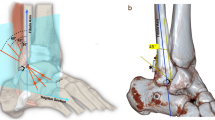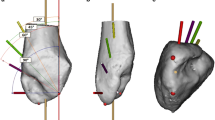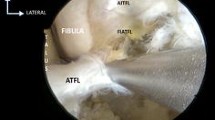Abstract
Purpose
Reconstruction of the anterior talofibular ligament may be indicated in cases of residual instability after conservative treatment. Often, a bone tunnel is used for fixation in the talar bone. The purpose of this study is to evaluate possible routes for drilling the talar tunnel.
Methods
Virtual tunnels were generated in a 3D bone model, oriented towards the following external landmarks: the talar neck, the most anterior point of the medial malleolus (MM), the most distal point of the MM, the most medial point of the MM, and the most posterior point of the MM. The parameters analysed for tunnels with lengths of 20, 25, and 30 mm were the maximum distance inside the bone and the distance from the tunnel to the bone surface. A minimal safe distance (MSD) was calculated for a tunnel with a diameter of 5 mm.
Results
The shortest measured distance before arriving outside the talar bone was 16.7 mm. The longest distances were obtained in the tunnels oriented towards the talar neck (mean value of 36.6, SD 2.8) and towards the most posterior point of the MM (mean value of 35.8, SD 0.3). Only one tunnel, measuring 20 mm in depth and oriented towards the most posterior point of the MM, revealed no individual values below the MSD.
Conclusion
External landmarks are useful for drilling a talar tunnel during reconstruction of the anterior talofibular ligament. Only one tunnel, oriented towards the most posterior point of the MM, measuring 5 mm in diameter and with a maximum depth of 20 mm, was safe in all individuals. Surgeons should be aware of these limits when treating patients with ankle instability.





Similar content being viewed by others
References
Bosien WR, Staples OS, Russell SW (1955) Residual instability following acute ankle sprains. J Bone Joint Surg Am 37:1237–1247
Brand RL, Black HM, Cox JS (1977) The natural history of inadequately treated ankle sprains. Am J Sports Med 5:248–249
Burks T, Morgan J (1994) Anatomy of the lateral ankle ligaments. Am J Sports Med 22:72–77
Clanton TO, McGarvey W (2007) Athletic injuries to the soft tissues of the foot and ankle. In: Coughlin MJ, Mann RA, Saltzman CL (eds) Surgery of the foot and ankle, 8th edn. Mosby Elsevier, Philadelphia, pp 1425–1563
Clanton TO, Viens NA, Campbell KJ, Laprade RF, Wijdicks CA (2014) Anterior talofibular ligament ruptures, part 2: biomechanical comparison of anterior talofibular ligament reconstruction using semitendinosus allografts with the intact ligament. Am J Sports Med 42:412–416
Daud R, Abdul Kadir MR, Izman S, Md Saad AP, Lee MH, Che Ahmad A (2013) Three-dimensional morphometric study of the trapezium shape of the trochlea tali. J Foot Ankle Surg 52:426–431
Golano P, Vega J, de Leeuw P, Malagelada F, Manzanares MC, Götzens V, van Dijk CN (2010) Anatomy of the ankle ligaments: a pictorial essay. Knee Surg Sports Traumatol Arthrosc 18:557–569
Guillo S, Bauer T, Lee JW, Takao M, Kong SW, Stone JW, Mangone PG, Molloy A, Perera A, Pearce CJ, Michels F, Tourné Y, Ghorbani A, Calder J (2013) Consensus in chronic ankle instability: aetiology, assessment, surgical indications and place for arhthroscopy. Orthop Traumatol Surg Res 99:411–419
Guillo S, Cordier G, Sonnery-Cottet B, Bauer T (2014) Anatomical reconstruction of the anterior talofibular and calcaneofibular ligaments with an all-arthroscopic surgical technique. Orthop Traumatol Surg Res 100:S413–S417
Guillo S, Takao M, Karlson J, Michels F, Bauer T, Ankle Instability Group (2015) Arthroscopic anatomical reconstruction of the lateral ankle ligaments. Knee Surg Sports Traumatol Arthrosc. doi:10.1007/s00167-015-3789-z
Jeys L, Korrosis S, Stewart T, Harris NJ (2004) Bone anchors or interference screws? A biomechanical evaluation for autograft ankle stabilization. Am J Sports Med 32(7):1651–1659
Jung HG, Kim TH, Park JY, Bae EJ (2012) Anatomic reconstruction of the anterior talofibular and calcaneofibular ligaments using a semitendinosus tendon allograft and interference screws. Knee Surg Sports Traumatol Arthrosc 20:1432–1437
Li HY, Hua YH, Wu ZY, Chen B, Chen SY (2013) Strength of suture anchor versus transosseous tunnel in anatomic reconstruction of the ankle lateral ligaments: a biomechanical study. Arthroscopy 29:1817–1825
Kuo CC, Lu HL, Leardini A, Lu TW, Kuo MY, Hsu HC (2014) Three-dimensional computer graphics-based ankle morphometry with computerized tomography for total ankle replacement design and positioning. Clin Anat 27:659–668
Michels F, Cordier G, Burssens A, Vereecke E, Guillo S (2015) Endoscopic reconstruction of CFL and the ATFL with a gracilis graft: a cadaveric study. Knee Surg Sports Traumatol Arthrosc. doi:10.1007/s00167-015-3779-1
Neuschwander T, Indressano A, Hughes T, Smith B (2013) Footprint of the lateral ligament complex of the ankle. Foot Ankle Int 34:582–586
Takao M, Oae K, Uchio Y, Ochi M, Yamamoto H (2005) Anatomical reconstruction of the lateral ligaments of the ankle with a gracilis autograft: a new technique using an interference fit anchoring system. Am J Sports Med 33:814–823
Taser F, Shafiq Q, Ebraheim NA (2006) Anatomy of lateral ankle ligaments and their relationship to bony landmarks. Surg Radiol Anat 28:391–397
Thès A, Klouche A, Ferrand M, Hardy P, Bauer T (2015) Assessment of the feasibility of arthroscopic visualization of the lateral ligament of the ankle: a cadaveric study. Knee Surg Sports Traumatol Arthrosc. doi:10.1007/s00167-015-3804-4
Wang B, Xu XY (2013) Minimally invasive reconstruction of lateral ligaments of the ankle using semitendinosus autograft. Foot Ankle Int 34:711–715
Acknowledgments
This research was supported by the Materialise Chair Handsurgery Kortrijk.
Author information
Authors and Affiliations
Consortia
Corresponding author
Ethics declarations
Conflict of interest
No benefits in any form have been received or will be received from a commercial party related directly or indirectly to the subject of this article.
Additional information
Ankle Instability Group, members are as follows: J. Batista, T. Bauer, J. Calder, W. J. Choi, A. Ghorbani, M. Glazebrook, S. Guillo, J. Karlsson, S. W. Kong, J. W. Lee, P. G. Mangone, F. Michels, A. Molloy, C. Nery, S. Ozeki, C. Pearce, A. Perera, H. Pereira, B. Pijnenburg, F. Raduan, J. W. Stone, M. Takao, Y. Tourné.
Rights and permissions
About this article
Cite this article
Michels, F., Guillo, S., Vanrietvelde, F. et al. How to drill the talar tunnel in ATFL reconstruction?. Knee Surg Sports Traumatol Arthrosc 24, 991–997 (2016). https://doi.org/10.1007/s00167-016-4018-0
Received:
Accepted:
Published:
Issue Date:
DOI: https://doi.org/10.1007/s00167-016-4018-0




